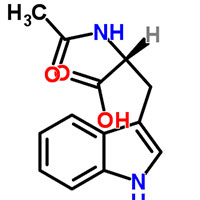Synonyms
AmbotzAAA1932
2-acetamido-3-(1H-indol-3-yl)propanoic acid
UNII:4460NBV53F
Tryptophan, N-acetyl-
N-Acetyltryptophan
(R)-2-Acetamido-3-(1H-indol-3-yl)propanoic acid
D-Tryptophan,N-acetyl
D-Tryptophan, N-acetyl-
N-Acetyl-Trp-OH
Ac-D-Trp-OH
Ac-D-tryptophan
MFCD00005644
N-Acetyl-D-tryptophan
Product Description
Introduction:
N-Acetyl-DL-tryptophan, commonly known as N-Acetyltryptophan or NADT, is a significant chemical compound
with wide-ranging applications in the chemical industry. This product introduction aims to provide an
overview of N-Acetyl-DL-tryptophan, covering its raw materials, production process, market trends, and
the current status of amino acids in the industry.
Raw Materials:
N-Acetyl-DL-tryptophan is synthesized using DL-tryptophan and acetic anhydride as the primary raw
materials. DL-tryptophan, an essential amino acid, serves as the precursor for NADT synthesis. Acetic
anhydride, derived from acetic acid, provides the acetyl group necessary for acetylation.
Production Process:
The production process of N-Acetyl-DL-tryptophan involves the following steps:
Step 1: Extraction of DL-tryptophan - DL-tryptophan can be obtained from natural sources, such as
protein-rich foods or fermentation of microbial cultures.
Step 2: Acetylation reaction - DL-tryptophan is reacted with acetic anhydride in the presence of
suitable catalysts and reaction conditions to form N-Acetyl-DL-tryptophan. The reaction takes place in a
solvent or under solid-state conditions, depending on the specific manufacturing process.
Step 3: Purification and refinement - The resulting N-Acetyl-DL-tryptophan is purified using techniques
such as filtration, crystallization, and chromatography to achieve the desired level of purity.
Market Trends:
The market demand for N-Acetyl-DL-tryptophan has been steadily increasing due to its versatile
applications across various industries. Here are some key market trends:
Pharmaceutical Industry: N-Acetyl-DL-tryptophan finds extensive use in the pharmaceutical industry. It
is utilized as a precursor for the synthesis of drugs and therapeutic compounds targeting neurological
disorders, mood regulation, and sleep disorders.
Nutraceuticals and Dietary Supplements: N-Acetyl-DL-tryptophan is widely used in the production of
nutraceuticals and dietary supplements. Its inclusion in these products is driven by its potential to
support mood enhancement, stress reduction, and sleep quality.
Chemical Research: N-Acetyl-DL-tryptophan serves as a valuable compound in chemical research,
particularly in the development of new pharmaceutical intermediates, catalysts, and specialty chemicals.
Its unique structure and functional groups make it a valuable tool for synthetic chemists.
Current Status of Amino Acids:
Amino acids play a crucial role in various sectors, including pharmaceuticals, food additives, animal
nutrition, and agriculture. The demand for amino acids continues to grow due to their diverse
applications and essential role in biological processes. Both essential and non-essential amino acids
are widely utilized in the industry.
Conclusion:
N-Acetyl-DL-tryptophan, derived from DL-tryptophan, holds significant value in the chemical industry.
Its production involves the combination of raw materials and precise manufacturing processes. The market
demand for N-Acetyl-DL-tryptophan is driven by its applications in pharmaceuticals, nutraceuticals,
dietary supplements, and chemical research. Amino acids, including DL-tryptophan, continue to play a
vital role in various industries, and N-Acetyl-DL-tryptophan maintains its position as a valuable
chemical compound with diverse applications.





